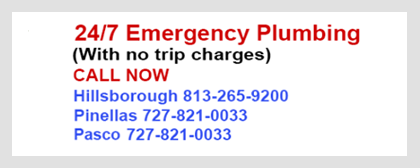 Shower drains can start to smell for several common reasons. Mold or mildew might be growing beneath the drain cover. Your p-trap could be malfunctioning, allowing sewer gas to rise up through your pipes. Or there could simply be hair or grime stuck in your shower drain strainer.
Shower drains can start to smell for several common reasons. Mold or mildew might be growing beneath the drain cover. Your p-trap could be malfunctioning, allowing sewer gas to rise up through your pipes. Or there could simply be hair or grime stuck in your shower drain strainer.
Luckily, most of the reasons your shower drain smells so bad right now are pretty easy to fix. Whether your drain smells like mildew or sulfur, we’ve listed the most likely causes of your stinky problem below. By following these tips, you should be able to find and remove it no problem. Let’s start with your strainer:
Clogged strainer or stopper
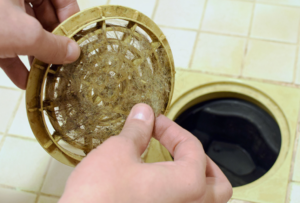 Almost all showers in Tampa have a strainer or stopper built over or into the drain. These fixtures catch hair, soap scum, and other debris before it flows down your drain. Over time, all the gunk and grime your strainer or stopper catches may begin to accumulate. The most common shower drain smell is probably some old, accumulated debris and shower runoff your strainer or stopper intercepted on its way down your drain.
Almost all showers in Tampa have a strainer or stopper built over or into the drain. These fixtures catch hair, soap scum, and other debris before it flows down your drain. Over time, all the gunk and grime your strainer or stopper catches may begin to accumulate. The most common shower drain smell is probably some old, accumulated debris and shower runoff your strainer or stopper intercepted on its way down your drain.
You could probably remove your stopper by hand. Strainers have a single Phillips screw you’ll have to remove with a small screwdriver. You’ll probably notice the buildup of hair, scum, and grease immediately after you pull out the strainer. Put on some gloves and use hot, soapy water, a sponge, or a bristle brush or old toothbrush to clean off the strainer. You should also clean out any scum left behind on the drainpipe where you removed the strainer.
Mold or mildew growth
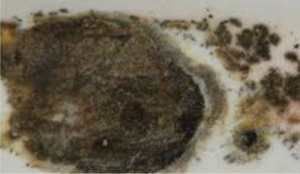 Mold and mildew love to grow in dark, wet places. If it has a chance to grow anywhere inside your shower, it will. When you take off your strainer/stopper, check to make sure it’s seated correctly. While you’re at it, check to make sure the drain cover itself is sealed properly as well. If there’s any space between the drain cover and the tub or the strainer and the tub, the gaps are an ideal place for mold or mildew to grow.
Mold and mildew love to grow in dark, wet places. If it has a chance to grow anywhere inside your shower, it will. When you take off your strainer/stopper, check to make sure it’s seated correctly. While you’re at it, check to make sure the drain cover itself is sealed properly as well. If there’s any space between the drain cover and the tub or the strainer and the tub, the gaps are an ideal place for mold or mildew to grow.
Remove your drain cover and stopper and clean each with a mold and mildew removal solution. Be sure to spray down and clean out the underside and ring around the drain, as well. When you’re finished, make sure that your cover sits over your drain completely snugly. If you can’t get it to sit properly, then it has warped and you should replace it right away.
Dry p-trap
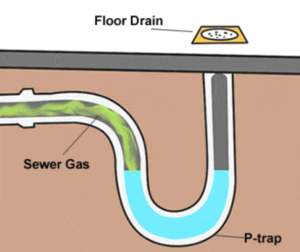 A “p-trap” is the curving portion of drain pipe that connects a fixture’s drain to the rest of your drain system. It’s called a “p-trap” because it curves in a distinctive p or u shape. The reason p-traps curve this way is so they can catch and hold a portion of the water that drains through them. This water helps block any sewer gases that might otherwise float up through your pipes where you could smell them.
A “p-trap” is the curving portion of drain pipe that connects a fixture’s drain to the rest of your drain system. It’s called a “p-trap” because it curves in a distinctive p or u shape. The reason p-traps curve this way is so they can catch and hold a portion of the water that drains through them. This water helps block any sewer gases that might otherwise float up through your pipes where you could smell them.
If you smell sewer gases or rotten eggs,your p-trap may not be doing its job. Remove your strainer and shine a flashlight down the drain. If you don’t see water, something could be wrong with the trap. Pour two cups of water down your drain and wait an hour. If the water isn’t there in an hour, consider giving us a call. You could also try pouring four ounces of cooking oil down the drain along with the water. The oil may help keep the water from evaporating.
Clogged or blocked vents
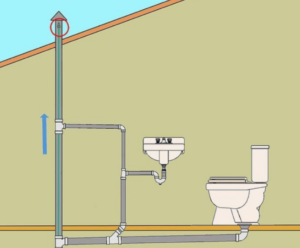 If the water you’re trying to introduce back into your p-trap keeps disappearing, it may be because your shower’s vents are blocked. Pipe venting gives the air pushed out by the introduction of water somewhere to go. Without it, suction inside your pipes could repeatedly siphon water out of your trap. Typically, vents connect to your trap and eventually connect to an outlet called a “vent stack.” Every pipe has a vent that connects to the vent stack.
If the water you’re trying to introduce back into your p-trap keeps disappearing, it may be because your shower’s vents are blocked. Pipe venting gives the air pushed out by the introduction of water somewhere to go. Without it, suction inside your pipes could repeatedly siphon water out of your trap. Typically, vents connect to your trap and eventually connect to an outlet called a “vent stack.” Every pipe has a vent that connects to the vent stack.
Most vent clogs occur in the vent stack. The stack could have a bird’s nest near its entrance, or debris could have fallen into the vent itself. If you know where your vent stack’s outlet is and can reach it safely, you could attempt to clear it yourself. First, remove anything from the mouth of the vent. If you don’t see anything, the problem could be further inside. Try running a hose down the stack’s outlet and turning it on. The pressure of the water should help clear the vent system.
If you tried each of these solutions with no luck, don’t panic! There’s still likely a straight-forward and uncomplicated solution. One of your individual pipe vents could be blocked, or you could have a sewage problem.
 Whatever the plumbing problem, call the Tampa Bay plumbing professionals at Cass Plumbing. We are here 24 hours a day, 7 days a week to serve you. Call us now at 813-265-9200 and schedule an appointment.
Whatever the plumbing problem, call the Tampa Bay plumbing professionals at Cass Plumbing. We are here 24 hours a day, 7 days a week to serve you. Call us now at 813-265-9200 and schedule an appointment.



